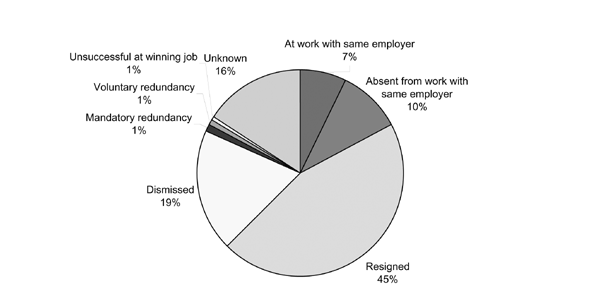A Bad Business - Fact Sheet: Cost to Employers
A Bad Business
(Review of sexual harassment in employment complaints 2002)
Media Pack
In this section you can access:
Media Pack Index | Media Release | Launch Speech by Pru Goward | Speech by Nareen Young | Case Studies
Fact Sheets: Key Findings | The Complaints Process | Legal Definition of Sexual Harassment | Cost to Employers
Fact Sheet:
Cost to Employers
Sexual harassment represents a cost to employers, in terms of disruption to the workplace, negative impacts on productivity and workplace culture, and in particular, employee absenteeism and employee turnover. Employers can also be held legally responsible for acts of sexual harassment committed by their employees or agents, exposing them to the possibility of legal proceedings and compensation payments. In order to meet their legal obligations, employers must take all reasonable steps to prevent sexual harassment occurring in their workplace.
The data show that harassment remains an issue for small, medium and large business in city, rural and remote rural areas. The data also indicate that there is more that employers could do to prevent sexual harassment and to address it where it does occur.
Employee turnover and absenteeism
Chart: Employment status of complainant at time complaint made to HREOC

At least three out of four complainants were no longer actively working for the organisation where the alleged harassment occurred by the time they reported the harassment to the Human Rights and Equal Opportunity Commission (HREOC). These complainants had been dismissed, made redundant, resigned, or were off work on unpaid leave, sick leave or workers’ compensation.
This represents a considerable cost to employers in recruitment, training and development, in addition to the indirect cost associated with loss of staff morale inevitably arising from unresolved disputes within workplaces.
Legal obligations
Many workplaces either do not have a sexual harassment policy or have not implemented their policy, leaving employers open to vicarious liability for the harassment.
In 130 complaints it was clear whether or not the complainant had reported the harassment via internal mechanisms. Amongst these complaints, 78 per cent of complainants (102 complainants) had reported the harassment internally.
Seventy-seven per cent of reporting of harassment was to people in a management or supervisory role. This indicates an expectation by complainants that senior people within an organisation would address complaints of sexual harassment. However, since complaints were subsequently made to HREOC in these cases, this also indicates that these managers and supervisors were unable to resolve the complaints in these cases. This has significant implications for business – indicating a need for managers and supervisors to be prepared and able to handle complaints of sexual harassment.
The majority of complaints involved employers who appeared not to have implemented sexual harassment policies fully or at all. Amongst all 152 complaints analysed, only 36 per cent (54 of 152 complaints) involved an employer who had a sexual harassment policy that had been fully implemented. [1] Half of the employers either did not have a policy or had not implemented the policy.
Compensation
It is important to note that compensation by the employer arising from conciliation does not necessarily represent an admission that harassment has occurred. There are many reasons why an employer may choose to pay compensation, including a desire to avoid litigation and publicity of the case, to settle the dispute more quickly or to minimise workplace disruption.
The amount of financial compensation received by complainants in cases resolved at HREOC varied widely, from a minimum of $500 to a maximum of $200,000. In almost all cases resolved at HREOC, the employer agreed to compensate the complainant, either as well as, or instead of the alleged harasser. This is a further price paid by employers who had failed to prevent or satisfactorily resolve the complaints themselves.
What employers can do
The data indicate that there is more that employers can do to prevent sexual harassment and to address it where it does occur. For example, this could include:
-
development and implementation of a sexual harassment policy, particularly by small business;
-
review of the adequacy of internal mechanisms for handling sexual harassment complaints;
-
ensuring internal complaints processes meet the expectations of staff;
-
better training for managers and supervisors so that they are prepared and able to handle complaints of sexual harassment;
-
greater use of training in response to complaints of sexual harassment, particularly as a means of preventing reoccurrences of this behaviour; and
-
inclusion of information about harassment in orientation for new staff.
Footnotes
1. An additional two cases have not been included as question of whether the sexual harassment policy had been implemented was in dispute between the parties.
This fact sheet is also available for download in ![]() PDF and
PDF and ![]() Word formats.
Word formats.
Last updated: 12 November 2003
